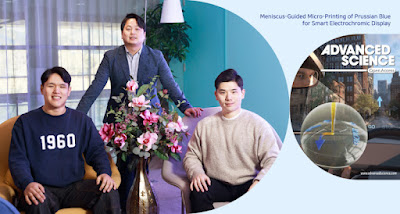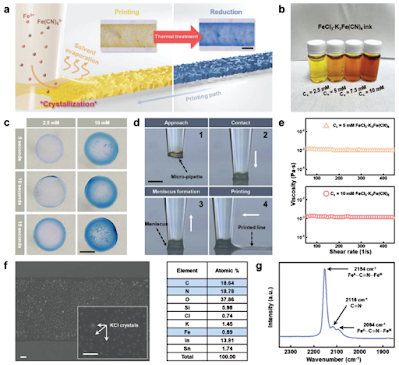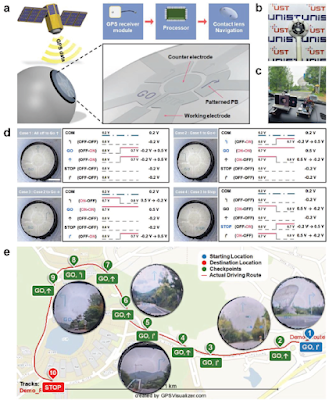|
About Topic In Short: |
|
|
|
Who: Institute
Name - University of Washington, Authors - Babak Parviz, Ehsan Saeedi, and
Andrew Lingley. |
|
What: Smart
contact lenses that can implement AR-based navigation by incorporating
microelectronics and wireless communication technologies. |
|
|
How: The
lenses are constructed by integrating microelectronics such as wireless
chips, antennas, and miniature LEDs into the soft contact lenses using layers
of polymers. The working involves sensing the surroundings through built-in
sensors, processing the information, displaying the information using micro
LEDs, and communicating wirelessly with external devices. |
|
Introduction
Smart contact
lenses have been a subject of interest in recent years. The ability to display
augmented reality (AR) on a contact lens can revolutionize the way we interact
with our surroundings. In this article, we will discuss the development of
smart contact lenses capable of implementing AR-based navigation.
Background
Smart contact
lenses are contact lenses that can provide various types of information,
including health monitoring and augmented reality. The main challenge in
developing smart contact lenses for AR is the requirement for low power
electrochromic displays. Previous methods for applying the required material,
pure Prussian blue, as a film on a substrate using electric plating have
limited the ability to produce advanced displays capable of expressing various
types of information such as letters, numbers, and images.
The Ink Meniscus Approach
Researchers
from the Smart 3D Printing team at KERI and Professor Lim-Doo Jeong's team at
Ulsan National Institute of Science and Technology (UNIST) have developed a new
core technology for smart contact lenses. This technology enables the
realization of AR by printing micro-patterns on a lens display using a 3D
printer, without the need for voltage. The key to this achievement is the
meniscus of the ink used in the process. The meniscus of
acidic-ferric-ferricyanide ink forms between the micronozzle and the substrate.
The precursor ions undergo spontaneous reactions leading to the heterogeneous
crystallization of FeFe(CN)6 on the substrate within the meniscus, and solvent
evaporation takes place on the surface of the meniscus. The meniscus phenomenon
offers a significant advantage in that there is no restriction on the type of
substrate used.
Printing Process
During the
printing process, precise nozzle movements enable the crystallization of
Prussian blue, resulting in the formation of micro-patterns. These patterns can
be formed on both flat and curved surfaces, producing very fine patterns with a
resolution of 7.2 micrometers. The resulting color is continuous and uniform,
making it ideal for smart contact lens displays for AR.
Applications
The primary
application area for smart contact lenses capable of AR-based navigation is
expected to be navigation. By wearing the lenses, AR-based navigation can be
displayed directly in front of the user's eyes. Additionally, popular games
like "Pokemon Go" can be enjoyed through the lenses without the need
for a smartphone.
Thus Speak Authors/Experts
According to
Dr. Seol Seung-Kwon of KERI, "Our achievement is a development of 3D
printing technology that can print functional micro-patterns on non-planner
substrate that can commercialize advanced smart contact lenses to implement AR.
It will greatly contribute to the miniaturization and versatility of AR
devices."
Conclusion
The
development of smart contact lenses capable of implementing AR-based navigation
is a significant achievement. The ink meniscus approach used in this technology
enables the realization of AR by printing micro-patterns on a lens display
using a 3D printer without the need for voltage. The primary application area
for this technology is expected to be navigation.
Image
Gallery
|
|
Professor Im Doo Jung (center) and his research team in the Department of Mechanical Engineering at UNIST. |
|
Image presents a schematic of the PB-based EC display with a navigation function in an AR smart contact lens that shows directions to the destination to a user on the EC display by receiving GPS coordinates in real time. Credit: Korea Electrotechnology Research Institute. |
|
Meniscus-guided micro-printing of Prussian blue (PB). |
|
Optical micrographs presenting the dependence of the printed line width on inner diameter (ID). |
|
Electrochromic (EC) display for navigation system embedded in a contact lens. |
|
Image showing meniscus phenomenon. Credit: Korea Electrotechnology Research Institute. |
|
All Images Credit: from References/Resources
sites [Internet] |
Hashtag/Keyword/Labels:
Smart contact lenses, AR-based navigation,
wearable technology, augmented reality, ophthalmology.
References/Resources:
For more such blog posts visit Index page or click InnovationBuzz label.
…till next post, bye-bye and take-care.








No comments:
Post a Comment